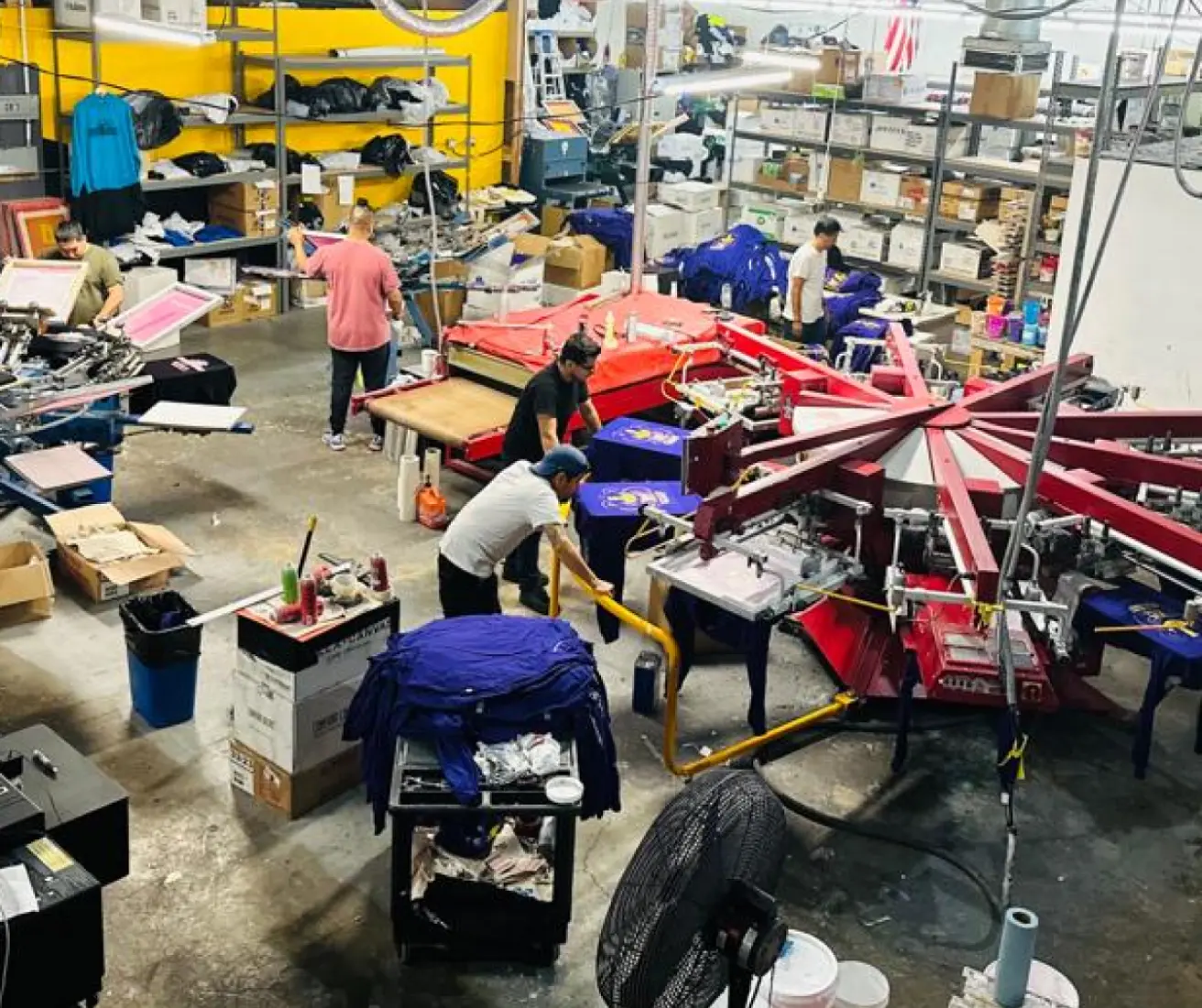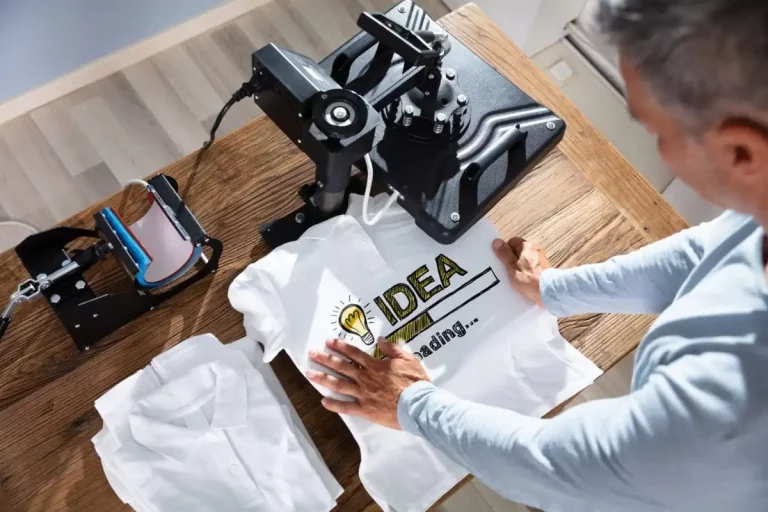Artistic Silk Screen Printing for Limited Edition Prints
Wiki Article
Screen Printing Uncovered: Whatever You Required to Know Regarding T-Shirt and Garment Printing Strategies
If you've ever questioned how those vibrant layouts wind up on your favorite tee shirts, you remain in the appropriate location. Screen printing is a remarkable technique that incorporates art with strategy, supplying unlimited opportunities for creativity. Comprehending the basics, from devices to ink selections, can considerably affect your results. All set to explore the important elements that make screen printing an art form? Allow's discover the details that can boost your tasks.
The Essentials of Screen Printing: How It Functions
When you dive into display printing, you'll find it's both an art and a science. At its core, display printing includes developing a pattern, or display, that permits ink to go through only in particular areas (screen printing kit). You start by picking your style and preparing your display with a light-sensitive emulsion. Once you reveal this emulsion to light, it hardens, leaving your style as a negative area.Position the screen over the textile, after that use a squeegee to push ink through the screen onto the garment. Each action is necessary, and mastering them will boost your display printing abilities, changing straightforward garments right into unique, meaningful items.
Sorts Of Display Printing Techniques
Once you grasp the fundamentals of screen printing, it's time to check out the numerous methods that can boost your designs. One preferred method is conventional display printing, where ink is pushed through a stenciled display. This technique is excellent for strong, vivid colors. There's water-based ink printing, which provides a softer feel and is green, yet it needs a various approach to curing.If you're going for fine information, consider discharge printing. This method eliminates dye from the textile, leaving a soft, classic appearance. An additional option is plastisol printing, known for its sturdiness and brilliant shades, making it a preferred for lots of brands. Experiment with halftone printing to create gradient effects and complex designs. Each method has its unique charm, so don't think twice to attempt them bent on locate what matches your style best!
Necessary Equipment for Display Printing
To accomplish stunning results in screen printing, having the best devices is basic. You'll require a tough display printing frame, which holds the mesh that moves your style onto the garment. Next, spend in high-quality squeegees; these are essential for applying ink equally throughout the screen.Selecting the Right Inks and Materials
When selecting inks and materials for screen printing, you need to consider the kind of ink that works best for your job. Think of textile compatibility to guarantee your layouts look last and terrific long. Explore green ink choices to make your printing process more lasting.Kinds Of Screen Inks
Picking the appropriate screen ink is vital for accomplishing dynamic, long lasting prints that fulfill your job's requirements. There are several kinds of display inks to examine. Plastisol ink is popular for its versatility and ease of use, giving exceptional color opacity on dark fabrics. Water-based ink, on the other hand, offers a softer feeling and is environmentally friendly, making it ideal for those aiming to lessen their environmental effect. Discharge inks eliminate dye from the material, resulting in a soft, classic look however require details handling. Finally, specialized inks, such as metal or glow-in-the-dark, can include special impacts to your styles. Assess your project demands and pick the ink that lines up finest with your wanted outcome.
Fabric Compatibility Considerations
Comprehending textile compatibility is important for achieving top notch display prints, specifically because various products respond distinctly to various inks. When picking inks, consider the fabric kind-- cotton, polyester, or blends. For cotton, water-based inks work well, using softness and breathability. Polyester, on the various other hand, commonly calls for plastisol inks for far better adhesion and dynamic colors. You might need to make use of a combination of both types if you're publishing on blends. Constantly examine your inks on example textile to ensure they stick appropriately and preserve shade integrity. Furthermore, keep in mind that textile weight and structure can affect the last outcome, so picking the best ink and product combo is vital for your job's success.Eco-Friendly Ink Options
Environmentally friendly inks are coming to be a preferred selection for display printers that desire to decrease their ecological effect while keeping high quality. When choosing inks, take into consideration water-based inks, which are much less harmful and simpler to cleanse up contrasted to typical solvents.Furthermore, seek inks made from eco-friendly sources, such as soy or vegetable-based alternatives. By choosing the ideal inks and materials, you'll not only create spectacular styles however likewise add to a more lasting printing procedure. Make the button, and your prints will certainly show your commitment to the environment!
Preparing Your Layout for Display Printing

Submit Layout Needs
To assure your layout looks vivid and sharp on fabric, you'll need to pay close attention to file style needs for screen printing. Make sure your design has a clear background to stop unwanted white edges on your prints. Keep color modes in mind; CMYK is common for display printing, so transform your RGB creates as necessary.Color Separation Methods
Color separation is a vital action in preparing your layout for display printing, and understanding it can greatly improve your print high quality. You'll require to break your style into private colors, as each color requires a different display during printing. Beginning by determining all the colors in your layout and produce layers for each one. You can use software like Adobe Photoshop or Illustrator to separate and different shades successfully. Be certain to save each layer as a different documents, typically in a layout like TIFF or PSD. This accuracy not just guarantees accurate shade representation however also improves the printing process. By taking note of shade separation, you'll accomplish specialist and dynamic lead to your screen-printed garments.Resolution and Size
Accomplishing the most effective cause display printing starts with assuring your design has the ideal resolution and size. Ideally, your art work ought to go to least 300 DPI (dots per inch) for sharp, clear prints. If you make use of lower resolution, your last product could look pixelated and amateur.When it involves dimension, think about the dimensions of your print location. Style your artwork to match the last print dimension, ideally producing it in the actual dimensions you'll be publishing. By doing this, you'll avoid any unanticipated scaling issues.
Always inspect your design in both vector and raster formats. Vector graphics can be scaled without shedding top quality, making them suitable for display printing. Preparing correctly will assure your style looks outstanding on every garment!
Step-by-Step Screen Printing Refine
Display printing is a vibrant procedure that permits you to develop vibrant styles on different surface areas. To get started, you'll need a display, solution, and your chosen ink.Pour ink onto the screen and use a squeegee to push the ink with the pattern onto the textile. Raise the screen thoroughly and let the print dry. You have actually effectively screen printed pop over to these guys your layout.
Tips for Successful Screen Printing Projects
While you're diving right into your screen printing jobs, bear in mind that preparation is crucial to success. Start by collecting all your materials-- inks, mops, garments, and screens. A clean work space aids prevent undesirable errors, so clean up prior to you begin.Following, verify your art work is high-resolution and appropriately sized for your garment. Test your display for appropriate direct exposure and tidy it thoroughly to stay clear of smudges. When blending your inks, comply with the manufacturer's standards to achieve the appropriate consistency.
Throughout printing, apply also pressure with your squeegee for constant outcomes. Don't hurry; take your time to validate each print satisfies your criteria. After printing, let your garments completely dry completely prior to handling or packaging them.
Finally, always keep a sample of your job for future recommendation. This means, you can examine your progress and improve your strategies in time. Happy printing!

Frequently Asked Questions
How Lengthy Does It Require To Establish a Screen Printing Job?
Establishing a display printing work commonly takes around 30 mins to an hour. You'll prepare the displays, mix inks, and change the press. The time differs based upon intricacy and experience, so remain arranged!Can I Publish on Various Textile Enters Utilizing the Exact Same Technique?
Yes, you can print on different material types utilizing the exact same method, however you'll need to adjust your settings and inks. Some fabrics soak up ink in different ways, so exploring assurances the most effective outcomes for every material.What Prevail Blunders to Stay Clear Of in Display Printing?
When display printing, prevent typical errors like utilizing the incorrect ink, ignoring correct direct exposure times, or missing pre-press checks. Always test your arrangement and preserve clean displays to ensure high quality results each time.How Can I Correctly Tidy and Preserve My Screen Printing Equipment?
To effectively tidy and preserve your screen printing equipment, you need to on a regular basis wash screens with proper solvents, inspect squeegees for wear, and ensure all tools are kept completely dry and dust-free. Consistency protects against costly repairs and improves performance.Is Display Printing Eco-friendly Compared to Other Approaches?
Screen printing can be much more eco friendly than other techniques, especially if you make use of eco-conscious products and water-based inks. By picking sustainable materials and techniques, you minimize waste and minimize your impact on the earth.Display Printing Uncovered: Whatever You Need to Know Regarding Tee Shirt and Garment go to these guys Printing Strategies
At its core, screen printing involves creating a stencil, or display, that enables ink to pass with only in details areas. Position the screen over the material, after that use a squeegee to push ink with the display onto the garment. One preferred approach is typical display printing, where ink is pressed via a stenciled screen.When choosing inks and materials for display printing, you require to take right into account the kind of ink that functions ideal for your project.
Report this wiki page